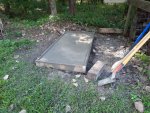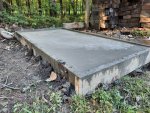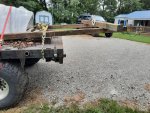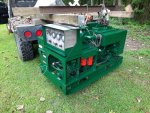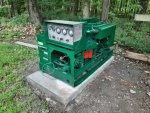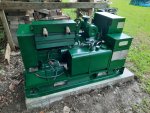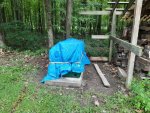Mr4btTahoe
Active member
- 128
- 74
- 28
- Location
- Indiana
Hey alls,
Now that I've got the unit somewhat buttoned up and load tested, it's time to put it in place and prepare it for use. In this thread, I'll detail how I'm doing just that... a lot of which I've never done.
Anyways... lets get started. First, I needed a solid location for the unit to sit. I have a firewood storage "building" (without walls) roughly 100' from our house. I decided to place the unit on the far end of this structure and to extend the roof over the unit. This will be two-fold. The roof and structure will protect the unit from the elements while the mass of firewood will be nice sound barrier between the house and the unit.
So.. we started by pouring a pad. Pad is roughly 5" poured by hand.. mixing in buckets. It went fairly smoothly. We also integrated some "footers" into the pad just to add a bit of strength. Formed it up with treated 2x6s and gave it a shot. This is the first time I've poured concrete. We were short on mix so we couldn't fill the form. Kinda sucks.. but we managed to get it fairly level and it doesn't seem to hold water now. It isn't perfect... but it'll serve it's purpose for sure.
Now that I've got the unit somewhat buttoned up and load tested, it's time to put it in place and prepare it for use. In this thread, I'll detail how I'm doing just that... a lot of which I've never done.
Anyways... lets get started. First, I needed a solid location for the unit to sit. I have a firewood storage "building" (without walls) roughly 100' from our house. I decided to place the unit on the far end of this structure and to extend the roof over the unit. This will be two-fold. The roof and structure will protect the unit from the elements while the mass of firewood will be nice sound barrier between the house and the unit.
So.. we started by pouring a pad. Pad is roughly 5" poured by hand.. mixing in buckets. It went fairly smoothly. We also integrated some "footers" into the pad just to add a bit of strength. Formed it up with treated 2x6s and gave it a shot. This is the first time I've poured concrete. We were short on mix so we couldn't fill the form. Kinda sucks.. but we managed to get it fairly level and it doesn't seem to hold water now. It isn't perfect... but it'll serve it's purpose for sure.
Attachments
-
257.3 KB Views: 42
-
227.7 KB Views: 41



